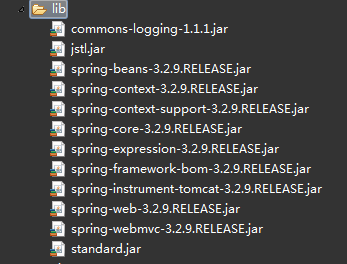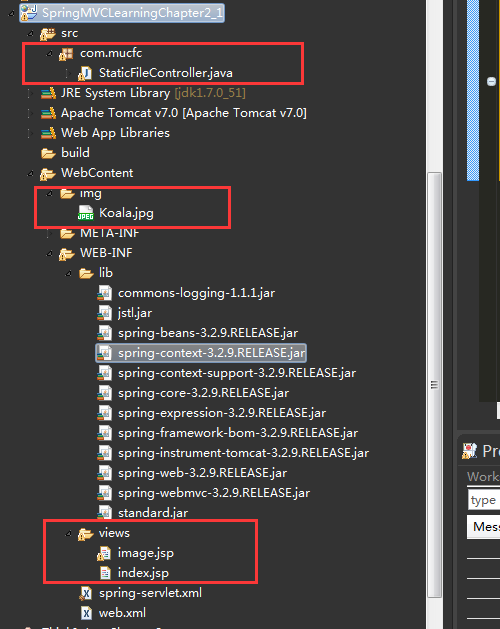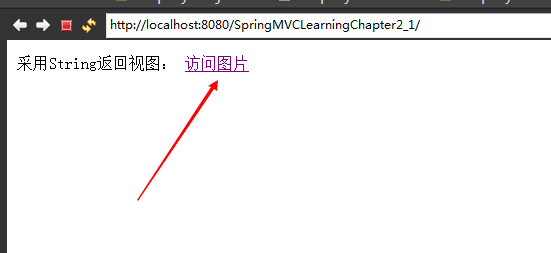SpringMVC訪問靜態資源例項講解
阿新 • • 發佈:2018-12-31
本文要以一個例子來說明SpringMVC訪問靜態資源
<mvc:resources 的使用方法:
<!--對靜態資原始檔的訪問-->
<mvc:resources mapping="/images/**" location="/images/" />如果出現下面的錯誤,可能是沒有配置 <mvc:annotation-driven /> 的原因。
報錯WARNING: No mapping found for HTTP request with URI [/mvc/user/findUser/lisi/770] in DispatcherServlet with name 'springMVC'
使用 <mvc:resources/> 元素,把 mapping 的 URI 註冊到 SimpleUrlHandlerMapping的urlMap 中,key 為 mapping 的 URI pattern值,而 value為 ResourceHttpRequestHandler,
這樣就巧妙的把對靜態資源的訪問由 HandlerMapping 轉到 ResourceHttpRequestHandler 處理並返回,所以就支援 classpath 目錄, jar 包內靜態資源的訪問.
另外需要注意的一點是,不要對 SimpleUrlHandlerMapping 設定 defaultHandler. 因為對 static uri 的 defaultHandler 就是ResourceHttpRequestHandler,
否則無法處理static resources request.
下面用一個例子來說明用法
1、在eclipse中新建一個web工程、
然後匯入如下包:
2、配置web.xml
<?xml version="1.0" encoding="UTF-8"?> <web-app xmlns:xsi="http://www.w3.org/2001/XMLSchema-instance" xmlns="http://java.sun.com/xml/ns/javaee" xmlns:web="http://java.sun.com/xml/ns/javaee/web-app_3_0.xsd" xsi:schemaLocation="http://java.sun.com/xml/ns/javaee http://java.sun.com/xml/ns/javaee/web-app_3_0.xsd" id="WebApp_ID" version="3.0"> <!-- <welcome-file-list> <welcome-file>index.html</welcome-file> <welcome-file>index.htm</welcome-file> <welcome-file>index.jsp</welcome-file> <welcome-file>default.html</welcome-file> <welcome-file>default.htm</welcome-file> <welcome-file>default.jsp</welcome-file> </welcome-file-list> --> <!-- SpringMVC的前端控制器 --> <servlet> <servlet-name>MyDispatcher</servlet-name> <servlet-class>org.springframework.web.servlet.DispatcherServlet</servlet-class> <!-- 載入配置檔案路徑 --> <init-param> <param-name>contextConfigLocation</param-name> <param-value>/WEB-INF/spring-servlet.xml</param-value> </init-param> <!-- 何時啟動 大於0的值表示容器啟動時初始化此servlet,正值越小優先順序越高--> <load-on-startup>1</load-on-startup> </servlet> <!-- Spring MVC配置檔案結束 --> <!-- SpringMVC攔截設定 --> <servlet-mapping> <servlet-name>MyDispatcher</servlet-name> <!-- 由SpringMVC攔截所有請求 --> <url-pattern>/</url-pattern> </servlet-mapping> <!-- SpringMVC攔截設定結束 --> </web-app>
3、然後是控制器:
package com.mucfc;
import javax.servlet.http.HttpServletRequest;
import javax.servlet.http.HttpServletResponse;
import org.springframework.stereotype.Controller;
import org.springframework.ui.ModelMap;
import org.springframework.web.bind.annotation.RequestMapping;
import org.springframework.web.servlet.ModelAndView;
@Controller
public class StaticFileController {
@RequestMapping(value="/image/test")
public ModelAndView img(HttpServletRequest request,HttpServletResponse response){
System.out.println("-----img-------");
return new ModelAndView("image");
}
@RequestMapping(value={"/index","/"})//相對於根目錄的路徑
public String test2() {
return "index";//指定頁面要跳轉的view檢視路徑
}
}
4、啟動註解:
<beans xmlns="http://www.springframework.org/schema/beans"
xmlns:context="http://www.springframework.org/schema/context"
xmlns:xsi="http://www.w3.org/2001/XMLSchema-instance" xmlns:p="http://www.springframework.org/schema/p"
xmlns:mvc="http://www.springframework.org/schema/mvc"
xsi:schemaLocation="
http://www.springframework.org/schema/mvc
http://www.springframework.org/schema/mvc/spring-mvc-3.0.xsd
http://www.springframework.org/schema/beans
http://www.springframework.org/schema/beans/spring-beans-3.0.xsd
http://www.springframework.org/schema/mvc
http://www.springframework.org/schema/mvc/spring-mvc-3.0.xsd
http://www.springframework.org/schema/context
http://www.springframework.org/schema/context/spring-context-3.0.xsd">
<!-- 把標記了@Controller註解的類轉換為bean -->
<context:component-scan base-package="com.mucfc"/>
<!-- 啟動Spring MVC的註解功能,完成請求和註解POJO的對映 -->
<bean class="org.springframework.web.servlet.mvc.annotation.AnnotationMethodHandlerAdapter" />
<!-- 靜態資源訪問(不攔截此目錄下的東西的訪問) -->
<mvc:annotation-driven />
<mvc:resources location="/img/" mapping="/img/**" />
<!-- 對模型檢視名稱的解析,即在模型檢視名稱新增前後綴 -->
<bean class="org.springframework.web.servlet.view.InternalResourceViewResolver"
p:prefix="/WEB-INF/views/" p:suffix=".jsp"/>
</beans>其中index.jsp:
<%@ page language="java" contentType="text/html; charset=gb2312"
pageEncoding="gb2312"%>
<!-- 這段程式碼的意思是獲取當前專案的路徑,如:http://localhost:8080/專案名稱。 -->
<%
String path = request.getContextPath();
String basePath = request.getScheme()+"://"+request.getServerName()+":"+request.getServerPort()+path+"/";
%>
<!DOCTYPE html PUBLIC "-//W3C//DTD HTML 4.01 Transitional//EN" "http://www.w3.org/TR/html4/loose.dtd">
<html>
<head>
<base href="<%=basePath%>">
<meta http-equiv="Content-Type" content="text/html; charset=gb2312">
<title>Insert title here</title>
</head>
<body>
採用String返回檢視:
<a href="image/test">訪問圖片</a>
</body>
</html>和image.jsp如下內容:
<%@ page language="java" contentType="text/html; charset=UTF-8"
pageEncoding="UTF-8"%>
<%@taglib prefix="c" uri="http://java.sun.com/jsp/jstl/core"%>
<%
String path = request.getContextPath();
String basePath = request.getScheme()+"://"+request.getServerName()+":"+request.getServerPort()+path+"/";
%>
<!DOCTYPE html PUBLIC "-//W3C//DTD HTML 4.01 Transitional//EN" "http://www.w3.org/TR/html4/loose.dtd">
<html>
<head>
<base href="<%=basePath%>">
<meta http-equiv="Content-Type" content="text/html; charset=UTF-8">
<title>Insert title here</title>
</head>
<body>
<h>圖片</h>
<br/>
<div>
<img alt="圖片" src="img/Koala.jpg">
</div>
</body>
</html>
6、在WebContent新建一個目錄,取名img,專門用來存放圖片:
把圖片考進去。
整個工程目錄 如下:
8、接下來就運行了:
可以通過這裡點選進去看圖片,也可以直接輸入http://localhost:8080/SpringMVCLearningChapter2_1/image/test



